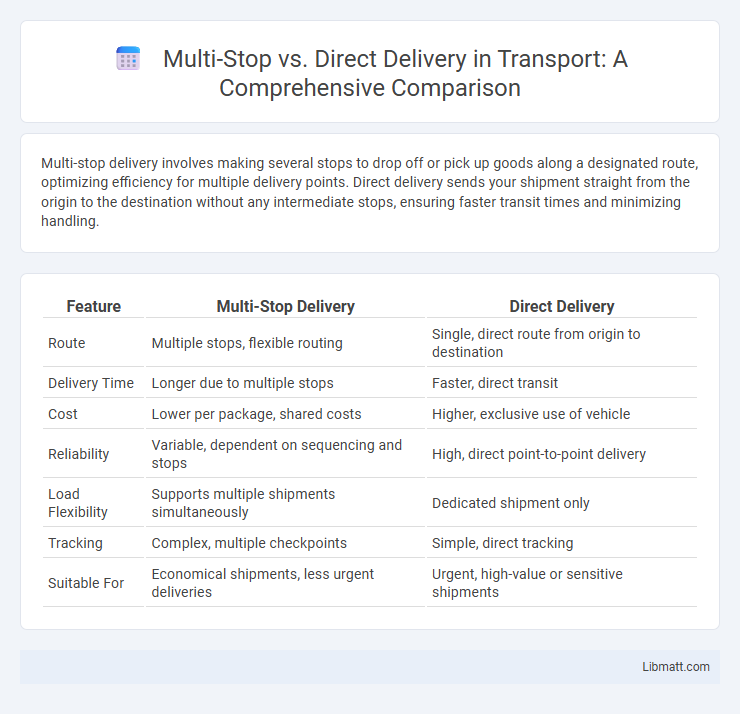Multi-stop delivery involves making several stops to drop off or pick up goods along a designated route, optimizing efficiency for multiple delivery points. Direct delivery sends your shipment straight from the origin to the destination without any intermediate stops, ensuring faster transit times and minimizing handling.
Table of Comparison
| Feature | Multi-Stop Delivery | Direct Delivery |
|---|---|---|
| Route | Multiple stops, flexible routing | Single, direct route from origin to destination |
| Delivery Time | Longer due to multiple stops | Faster, direct transit |
| Cost | Lower per package, shared costs | Higher, exclusive use of vehicle |
| Reliability | Variable, dependent on sequencing and stops | High, direct point-to-point delivery |
| Load Flexibility | Supports multiple shipments simultaneously | Dedicated shipment only |
| Tracking | Complex, multiple checkpoints | Simple, direct tracking |
| Suitable For | Economical shipments, less urgent deliveries | Urgent, high-value or sensitive shipments |
Introduction to Multi-Stop and Direct Delivery
Multi-stop delivery involves transporting goods to multiple destinations in a single route, optimizing efficiency for businesses managing numerous orders. Direct delivery sends products straight from the warehouse to the final customer, reducing handling time and minimizing the risk of delays. Understanding the differences helps your supply chain achieve the balance between speed and cost-effectiveness.
What is Multi-Stop Delivery?
Multi-stop delivery involves a single vehicle making multiple stops to deliver goods to various locations within one route, enhancing efficiency for businesses with several delivery points. This method reduces transportation costs and transit time by consolidating shipments, compared to direct delivery where each order is shipped individually. Key benefits include optimized route planning, reduced fuel consumption, and improved customer satisfaction through timely deliveries across multiple stops.
What is Direct Delivery?
Direct delivery refers to the process of transporting goods directly from the supplier or warehouse to the final customer without any intermediate stops or transfers. This method reduces handling time, minimizes the risk of damage or loss, and ensures faster delivery compared to multi-stop routes. Businesses often prefer direct delivery for time-sensitive or high-value shipments to enhance efficiency and customer satisfaction.
Key Differences Between Multi-Stop and Direct Delivery
Multi-stop delivery involves a single vehicle making several scheduled stops to drop off or pick up goods, optimizing routes and reducing transportation costs by consolidating shipments. Direct delivery sends goods straight from the supplier to the final destination without intermediate stops, ensuring faster transit times and reduced handling risks. Understanding these differences helps you choose the best logistics strategy based on delivery speed, cost efficiency, and cargo sensitivity.
Cost Comparison: Multi-Stop vs Direct Delivery
Multi-stop deliveries typically reduce overall shipping costs by consolidating multiple drop-offs into a single route, lowering fuel and labor expenses compared to direct delivery. Direct delivery incurs higher costs due to dedicated routes and increased mileage for each individual shipment, which can outweigh efficiency gains in small batch sizes. You should consider your delivery volume and time sensitivity to determine if cost savings from multi-stop routes align with your business needs.
Time Efficiency Analysis
Direct delivery significantly reduces transit times by minimizing handling and routing complexity, enabling faster arrival at the destination compared to multi-stop delivery, which involves multiple stops and increased dwell times. Multi-stop delivery, while cost-effective for consolidated shipments, often experiences delays due to loading and unloading at each intermediate point, decreasing overall time efficiency. Time-sensitive shipments benefit from direct delivery, optimizing supply chain speed and minimizing the risk of late delivery penalties.
Environmental Impact of Delivery Methods
Multi-stop delivery increases carbon emissions due to extended routes and frequent stops, leading to higher fuel consumption compared to direct delivery. Direct delivery optimizes fuel efficiency by minimizing travel distance and reducing the number of stops, significantly lowering your carbon footprint. Choosing direct delivery supports sustainable transportation practices and helps mitigate environmental impact.
Suitability for Different Business Needs
Multi-stop delivery is ideal for businesses that require flexible and cost-effective distribution to multiple locations, such as local retailers or small-scale suppliers. Direct delivery suits companies prioritizing speed and reliability for a single destination, like e-commerce platforms with time-sensitive shipments. Choosing between multi-stop and direct delivery depends on factors like shipment volume, delivery urgency, and geographic coverage.
Challenges and Risks of Each Method
Multi-stop delivery faces challenges like increased risk of delays, higher fuel consumption, and potential misrouting that can affect your overall efficiency. Direct delivery minimizes handling and transit times but often involves higher shipping costs and less flexibility in route adjustments. Both methods carry risks related to timing accuracy and customer satisfaction depending on the logistics strategy chosen.
Choosing the Best Delivery Option for Your Business
Choosing the best delivery option for your business depends on factors like cost, speed, and customer satisfaction. Multi-stop delivery reduces expenses by consolidating shipments but may increase transit time, while direct delivery ensures faster, more reliable shipments at a higher cost. Assessing your specific logistics needs and customer expectations will help you determine whether multi-stop or direct delivery aligns better with your operational goals.
multi-stop vs direct delivery Infographic

 libmatt.com
libmatt.com